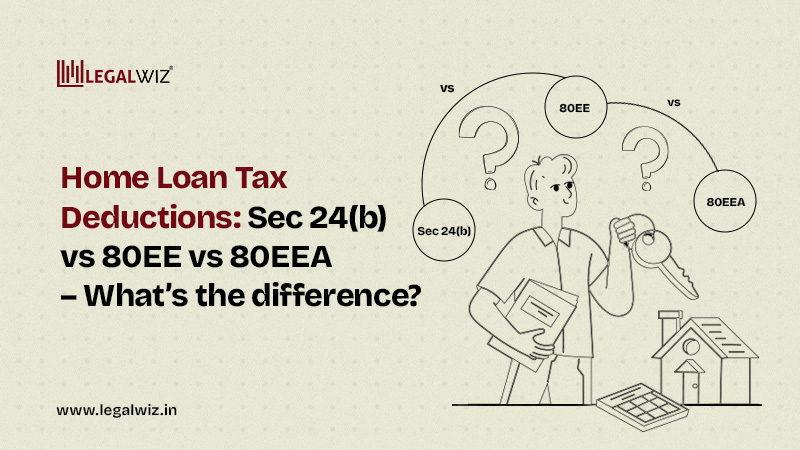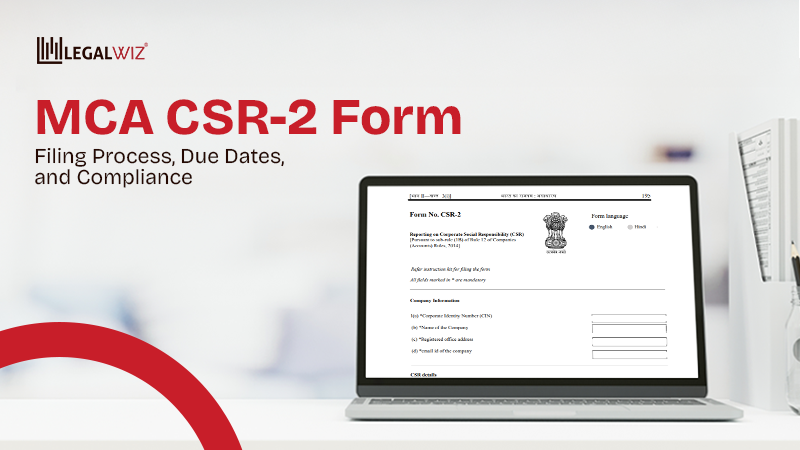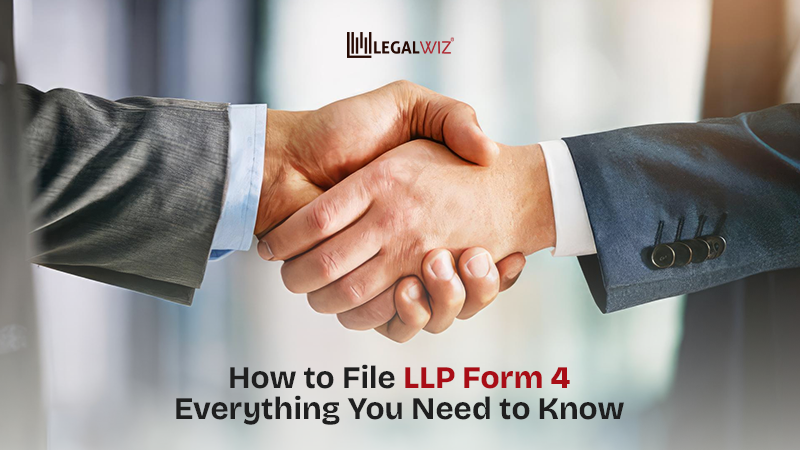Home Loan Tax Deductions: Sec 24(b) vs 80EE vs 80EEA
Your home loan isn’t just a big financial commitment – it’s also a sneaky little tax-saving tool! (If you know which tax sections to claim, that is.)
When it comes to saving tax on your home loan, there are three superstar sections in the Income Tax Act you need to know about:
- Section 24(b)
- Section 80EE
- Section 80EEA
Each of these gives you a different kind of tax deduction, depending on things like your loan amount, the type of property, and when you took the loan.
Don’t forget: Once you’ve figured out your deductions, make sure to file your ITR to claim your benefits and stay compliant.
By the end of this guide, you’ll discover:
- What each section really means for your pocket,
- Who qualifies for which deduction, and
- How to stack them (smartly) for maximum income tax savings.
But first… why does the government even hand out these deductions? Spoiler: It’s not just generosity, it’s strategy! Understanding how each section of 80C to 80U impacts your tax savings can make a real difference—see what you need to know.
1. Why Home Loan Tax Benefits Exist? (The Feel-Good Part)
Because the government loves it when you own a house—and not just scroll through property listings at midnight!
Home loan tax benefits weren’t created just to make taxpayers smile. They were introduced to encourage home ownership, stimulate the real estate sector, and give people a financial nudge toward building long-term assets.
A quick flashback:
- Over the years, sections like 24(b), 80EE, and 80EEA have evolved through budget announcements to provide relief on interest payments and make housing more affordable—especially for first-time buyers.
- Think of these deductions as little financial cheerleaders — here to ease the EMI burden and give a high-five to anyone bold enough to dive into homeownership.
For first-time homebuyers, they’re not just perks, they’re game-changers! By trimming down the real cost of your loan, they bring that dream home a whole lot closer.
For existing owners, they help cushion the blow of interest outflows while creating opportunities for additional tax planning.
Now that you know the “why,” it’s worth seeing what steps to take after filing ITR before diving into the big three—starting with the OG, Section 24(b).
2. Section 24(b) – The OG Home Loan Deduction
Think of it as the classic filter coffee of tax benefits – old, reliable, and always there to perk up your finances.
Under Section 24(b) of the Income Tax Act, you can claim a deduction on the interest paid on your home loan. Here’s the lowdown:
- Deduction Limit: Up to ₹2,00,000 per year for a self-occupied property.
- For let-out or deemed-to-be-let-out property: No upper cap on interest deduction (but subject to the overall loss from house property set-off limit of ₹2,00,000 per year).
To see what forms and processes are involved in filing correctly, check the ITR-1 to ITR-7 form guide that every taxpayer should read.
Eligibility & Conditions
- Got a home loan? Great! Just make sure it’s for buying, building, repairing, or jazzing up a house — that’s the rule.
- To grab the full ₹2,00,000 deduction under Section 24(b), your construction must wrap up within 5 years from the end of the financial year you took the loan. Tick-tock!
- And if you paid interest before the house was ready? No worries — you can claim that too, spread out over 5 equal slices starting from the year you get possession or the project finishes. Tasty, right?
In short, Section 24(b) covers the biggest expense on your home loan—interest—and rewards you with a solid tax break for it.
But what if you’re a first-time homebuyer looking for a little extra? Enter Section 80EE—the bonus shot of tax savings.
3. Section 80EE – The First-Time Buyer’s Bonus
If Section 24(b) is the coffee, 80EE is that extra shot of espresso—just for first-timers.
Section 80EE is like a bonus level unlocked just for first-time homebuyers — especially those young earners dreaming big! It lets you claim an extra ₹50,000 on your home loan interest.
Stack that on top of the usual ₹2,00,000 under Section 24(b), and you could be looking at a total deduction of ₹2,50,000 — if you tick all the right boxes, of course!
To see how these deductions fit within the new tax regime, check the new Income Tax Regime 2025-26: Rates, Rebate & Deductions.
Eligibility Criteria (Non-Negotiable)
- Loan sanction period: Must be between 1st April 2016 and 31st March 2017. (No deductions for loans sanctioned outside this window.)
- Loan amount: Should not exceed ₹35 lakh.
- Property value: Should not exceed ₹50 lakh.
- Ownership rule: Applicant must not own any other residential property at the time of loan sanction.
Why It Matters for Young Buyers
- Offers relief during the early years of homeownership when EMIs are interest-heavy.
- Provides extra tax savings at a stage when disposable income is often tight due to parallel financial goals (wedding, car loan, startup capital).
- Encourages first-time buyers to enter the property market confidently.
Pro Tip: Since 80EE applies only to loans sanctioned in FY 2016–17, most new buyers won’t qualify. But don’t worry, Section 80EEA was introduced later to cover affordable housing loans for a wider audience.
4. Section 80EEA – The Affordable Housing Hero
80EEA is like the government saying – “Congrats on adulting! Here’s another tax-break hug.”
Launched in Budget 2019, Section 80EEA came in like a housing superhero — aiming to help first-time buyers tackle sky-high property prices, especially in bustling metros and fast-growing towns.
The perk? An extra ₹1,50,000 deduction on home loan interest, on top of the ₹2,00,000 you already get under Section 24(b). That’s more savings, less stress, and a smoother ride to your dream home!
Key Conditions (Read Carefully)
- Loan sanction period: Between 1st April 2019 and 31st March 2022 (extended through subsequent budgets).
- Stamp duty value of property: Should not exceed ₹45 lakh.
- First-time ownership: Buyer must not own any other residential property at the time of loan sanction.
- Not applicable if deduction is already claimed under 80EE.
Why It Matters
- Ideal for middle-income taxpayers buying budget-friendly homes.
- It’s like a double scoop of savings! With ₹2,00,000 from Section 24(b) and another ₹1,50,000 from 80EEA, you could save up to ₹3,50,000 on interest. That means lighter EMIs and a smoother path to owning your dream home — without breaking the bank!
- Encourages new housing demand, which in turn supports real estate growth.
Note: With 80EEA, affordability is key. If your property value crosses ₹45 lakh, you lose eligibility—no exceptions.
To understand how these home loan deductions can impact your ITR filing, see how to fill form 10-IEA for tax regime & HRA claims.
5. The Big Question – Can You Claim All Three?
Many taxpayers wonder—Can I stack all three deductions and double (or triple) my tax savings?
Short answer:
- You can combine Section 24(b) with either 80EE OR 80EEA,
- But you cannot claim both 80EE and 80EEA together.
- Why? Because both sections target first-time buyers, the law doesn’t allow double-dipping.
Comparison Table: 24(b) vs 80EE vs 80EEA
| Parameter | Section 24(b) | Section 80EE | Section 80EEA |
| Deduction Limit | Up to ₹2,00,000 (self-occupied) | Up to ₹50,000 (additional) | Up to ₹1,50,000 (additional) |
| Eligibility | All home loan borrowers | First-time buyers (loan sanctioned FY 2016–17) | First-time buyers (loan sanctioned FY 2019–22) |
| Property Value Cap | None | ₹50 lakh | ₹45 lakh (stamp duty value) |
| Loan Amount Cap | None | ₹35 lakh | None |
| Can Combine With | 80EE or 80EEA | 24(b) only | 24(b) only |
Practical Scenarios – How These Deductions Work in Real Life
1. Salaried Person Buying Their First Home (Loan Sanctioned in FY 2019–22)
- Eligible Deductions: Section 24(b) + Section 80EEA
- Maximum Claim: ₹2,00,000 (24b) + ₹1,50,000 (80EEA) = ₹3,50,000 annually
- Why?
- 80EEA applies because the property is affordable (≤ ₹45 lakh stamp duty value) and the loan was sanctioned within the eligible period.
- 80EE cannot be claimed simultaneously.
2. Buyer with Loan Sanctioned in FY 2016–17
- Eligible Deductions: Section 24(b) + Section 80EE
- Maximum Claim: ₹2,00,000 (24b) + ₹50,000 (80EE) = ₹2,50,000 annually
- Why?
- Deduction under 80EE is available only for loans sanctioned in FY 2016–17 with property value ≤ ₹50 lakh and loan ≤ ₹35 lakh.
3. Second Property Purchase
- Eligible Deductions: Only Section 24(b)
- Maximum Claim: ₹2,00,000 annually (self-occupied) or no cap for let-out property (but overall loss adjustment restricted to ₹2,00,000).
- Why?
- 80EE and 80EEA are exclusively for first-time buyers; repeat buyers cannot claim these additional benefits.
These scenarios can influence your tax planning and filing deadlines, so it helps to understand the rules around belated ITR submission: Belated ITR Filing: Due Dates, Late Fees & Online Filing Process.
6. Common Mistakes to Avoid while Claiming
Because nothing ruins a tax refund faster than a section mismatch!
Even seasoned taxpayers slip up when it comes to home loan deductions. Here are the biggies to watch out for:
1. Claiming Ineligible Deductions
- Trying to claim 80EE or 80EEA without meeting first-time buyer conditions or property value limits.
- Pro tip: Always double-check your sanction year and eligibility before filing.
2. Ignoring Loan Sanction Dates & Property Value Caps
- Claiming 80EE for loans taken after 31st March 2017? Not allowed.
- Claiming 80EEA for properties over ₹45 lakh? Immediate disqualification.
- Missing these details can trigger a notice from the tax department.
3. Mixing Up Principal vs Interest Deductions
- Remember:
- Section 24(b), 80EE, and 80EEA deal with interest payments only.
- Principal repayment comes under Section 80C (limit: ₹1.5 lakh).
4. Overlooking Pre-Construction Interest Rules
- Many forget that pre-construction interest is claimable in five equal instalments, starting from the year of possession.
To avoid common pitfalls and ensure your deductions are correctly claimed, see the ITR filing last date for FY 2024–25.
Final Takeaway
Home loan deductions may look similar, but each section serves a specific purpose—so you can choose wisely and file your ITR to claim your savings.
- Section 24(b): The standard deduction for all home loan borrowers – up to ₹2,00,000 on interest.
- Section 80EE: A bonus deduction for first-time buyers (loans sanctioned in FY 2016–17) – up to ₹50,000 extra.
- Section 80EEA: The bigger bonus for affordable housing buyers (loans sanctioned in FY 2019–22) – up to ₹1,50,000 extra.
Choosing the right section can mean thousands in tax savings every year.
Ready to decode your deductions? Consult a tax expert from LegalWiz.in before filing and save smart.
Frequently Asked Questions
Can I claim both 80EE and 80EEA?
No. You can claim either 80EE or 80EEA, depending on your loan sanction year and eligibility, but not both together. However, either of them can be combined with Section 24(b).
Is Section 24(b) available on a second home?
Yes, but with conditions. While there’s no upper cap for interest deduction on a second home, the overall loss from house property set-off is restricted to ₹2,00,000 in a financial year.
Can I claim deductions for an under-construction property?
Not immediately. Interest paid during the pre-construction phase can be claimed in five equal instalments starting from the year of possession or completion.
What if I took a joint home loan?
Each co-borrower who is also a co-owner of the property can claim deductions individually, provided they contribute to EMI payments. This can double the tax benefit for the same property.

Sapna Mane
Sapna Mane is a skilled content writer at LegalWiz.in with years of cross-industry experience and a flair for turning legal, tax, and compliance chaos into clear, scroll-stopping content. She makes sense of India’s ever-changing rules—so you don’t have to Google everything twice.







